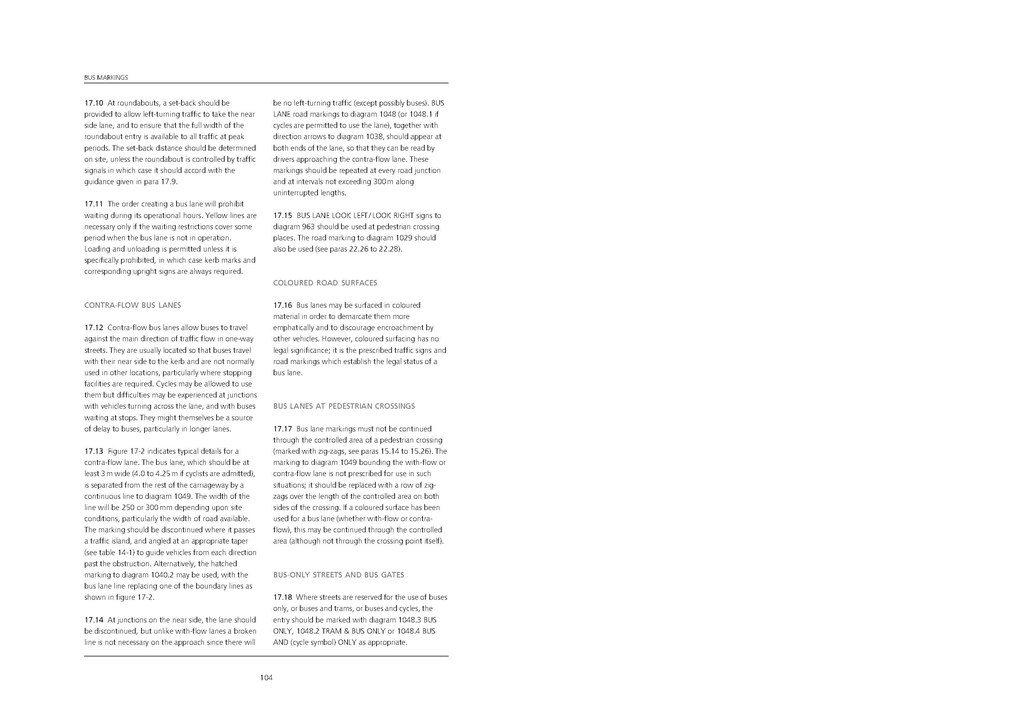17.10 At roundabouts, a set-back should be provided to allow left-turning traffic to take the near side lane, and to ensure that the full width of the roundabout entry is available to all traffic at peak periods. The set-back distance should be determined on site, unless the roundabout is controlled by traffic signals in which case it should accord with the guidance given in para 17.9.
17.11 The order creating a bus lane will prohibit waiting during its operational hours. Yellow lines are necessary only if the waiting restrictions cover some period when the bus lane is not in operation. Loading and unloading is permitted unless it is specifically prohibited, in which case kerb marks and corresponding upright signs are always required.
CONTRA-FLOW BUS LANES
17.12 Contra-flow bus lanes allow buses to travel against the main direction of traffic flow in one-way streets. They are usually located so that buses travel with their near side to the kerb and are not normally used in other locations, particularly where stopping facilities are required. Cycles may be allowed to use them but difficulties may be experienced at junctions with vehicles turning across the lane, and with buses waiting at stops. They might themselves be a source of delay to buses, particularly in longer lanes.
17.13 Figure 17-2 indicates typical details for a contra-flow lane. The bus lane, which should be at least 3 m wide (4.0 to 4.25 m if cyclists are admitted), is separated from the rest of the carriageway by a continuous line to diagram 1049. The width of the line will be 250 or 300 mm depending upon site conditions, particularly the width of road available. The marking should be discontinued where it passes a traffic island, and angled at an appropriate taper (see table 14-1) to guide vehicles from each direction past the obstruction. Alternatively, the hatched marking to diagram 1040.2 may be used, with the bus lane line replacing one of the boundary lines as shown in figure 17-2.
17.14 At junctions on the near side, the lane should be discontinued, but unlike with-flow lanes a broken line is not necessary on the approach since there will be no left-turning traffic (except possibly buses). BUS LANE road markings to diagram 1048 (or 1048.1 if cycles are permitted to use the lane), together with direction arrows to diagram 1038, should appear at both ends of the lane, so that they can be read by drivers approaching the contra-flow lane. These markings should be repeated at every road junction and at intervals not exceeding 300 m along uninterrupted lengths.
17.15 BUS LANE LOOK LEFT / LOOK RIGHT signs to diagram 963 should be used at pedestrian crossing places. The road marking to diagram 1029 should also be used (see paras 22.26 to 22.28).
COLOURED ROAD SURFACES
17.16 Bus lanes may be surfaced in coloured material in order to demarcate them more emphatically and to discourage encroachment by other vehicles. However, coloured surfacing has no legal significance; it is the prescribed traffic signs and road markings which establish the legal status of a bus lane.
BUS LANES AT PEDESTRIAN CROSSINGS
17.17 Bus lane markings must not be continued through the controlled area of a pedestrian crossing (marked with zig-zags, see paras 15.14 to 15.26). The marking to diagram 1049 bounding the with-flow or contra-flow lane is not prescribed for use in such situations; it should be replaced with a row of zigzags over the length of the controlled area on both sides of the crossing. If a coloured surface has been used for a bus lane (whether with-flow or contraflow), this may be continued through the controlled area (although not through the crossing point itself).
BUS-ONLY STREETS AND BUS GATES
17.18 Where streets are reserved for the use of buses only, or buses and trams, or buses and cycles, the entry should be marked with diagram 1048.3 BUS ONLY, 1048.2 TRAM & BUS ONLY or 1048.4 BUS AND (cycle symbol) ONLY as appropriate.
104
